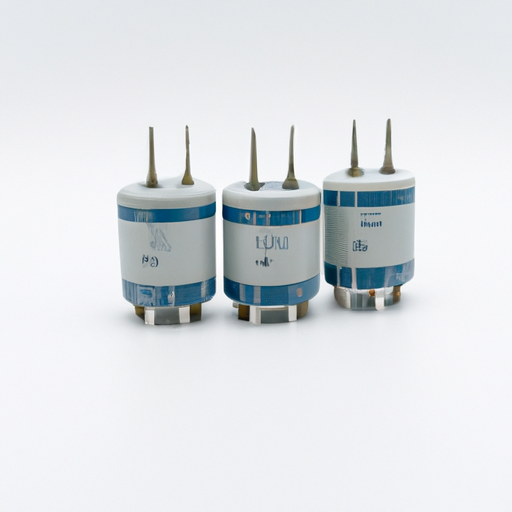Core Functional Technologies of Film Capacitors
1. Dielectric Material: Film capacitors utilize thin plastic films as the dielectric material, which can be made from various polymers such as polyester (PET), polypropylene (PP), and polycarbonate (PC). The choice of dielectric affects the capacitor's performance, including capacitance stability, temperature coefficient, and voltage rating. For instance, polypropylene is known for its low dielectric losses and high insulation resistance, making it ideal for high-frequency applications.

2. Low ESR and ESL: Film capacitors typically exhibit low equivalent series resistance (ESR) and equivalent series inductance (ESL), making them suitable for high-frequency applications. This characteristic allows for efficient energy storage and discharge, minimizing power losses. In applications like switching power supplies, low ESR is critical for reducing heat generation and improving overall efficiency.
3. High Voltage Ratings: Film capacitors can handle high voltage applications, making them ideal for power electronics, motor drives, and renewable energy systems. The CFR-25JB-52-1M1, for example, is designed to operate effectively in high-voltage environments, ensuring reliability in demanding applications such as grid-tied inverters.
4. Temperature Stability: Film capacitors maintain stable capacitance over a wide temperature range, which is crucial for applications in harsh environments. This stability is often better than that of ceramic capacitors, especially in high-temperature scenarios. For example, in automotive applications, where temperature fluctuations are common, film capacitors provide consistent performance.
5. Long Lifespan: With a robust construction and resistance to environmental factors, film capacitors have a long operational life, often exceeding 100,000 hours. This longevity reduces maintenance costs and enhances reliability in critical applications, such as industrial automation and medical devices.
6. Self-Healing Properties: Many film capacitors possess self-healing capabilities, meaning that if a dielectric breakdown occurs, the capacitor can recover without permanent damage. This feature enhances reliability and safety in electronic circuits, making them suitable for applications where failure is not an option, such as aerospace and defense systems.
Application Development Cases
1. Power Electronics: Film capacitors are extensively used in power supply circuits, inverters, and converters. Their ability to handle high ripple currents and voltages makes them ideal for applications in renewable energy systems, such as solar inverters and wind turbine converters. For example, in a solar inverter, film capacitors help smooth out voltage fluctuations, improving overall system efficiency.
2. Audio Equipment: In high-fidelity audio applications, film capacitors are preferred for coupling and bypassing due to their low distortion and high linearity. They help maintain audio signal integrity, making them a popular choice in high-end audio equipment. For instance, audiophile-grade amplifiers often use film capacitors to ensure the best sound quality.
3. Motor Drives: In variable frequency drives (VFDs) for electric motors, film capacitors are used for DC link applications. Their low ESR and ESL characteristics help improve the efficiency and performance of motor control systems. In industrial automation, this leads to better energy savings and reduced operational costs.
4. Telecommunications: Film capacitors are used in RF applications, including filters and oscillators, due to their stability and low loss at high frequencies. They are essential in maintaining signal integrity in communication systems, such as cellular base stations, where reliable performance is critical.
5. Lighting Applications: In LED drivers and electronic ballasts, film capacitors are used for energy storage and filtering. Their ability to handle high-frequency switching and provide stable performance contributes to the efficiency of lighting systems. For example, in LED street lighting, film capacitors help ensure consistent brightness and energy efficiency.
6. Automotive Applications: With the rise of electric vehicles (EVs) and advanced driver-assistance systems (ADAS), film capacitors are increasingly used in automotive electronics for energy storage, filtering, and signal processing, ensuring reliability in demanding environments. They play a crucial role in battery management systems, helping to optimize performance and extend battery life.
Conclusion
Film capacitors, such as the CFR-25JB-52-1M1, play a crucial role in modern electronics due to their unique properties and versatility. Their application across various industries—from power electronics to telecommunications—demonstrates their effectiveness in enhancing performance, reliability, and efficiency in electronic systems. As technology continues to evolve, the demand for high-performance film capacitors is expected to grow, driving further innovation in this field. The ongoing development of new dielectric materials and manufacturing techniques will likely expand the capabilities and applications of film capacitors, solidifying their position as a key component in future electronic designs.
Core Functional Technologies of Film Capacitors
1. Dielectric Material: Film capacitors utilize thin plastic films as the dielectric material, which can be made from various polymers such as polyester (PET), polypropylene (PP), and polycarbonate (PC). The choice of dielectric affects the capacitor's performance, including capacitance stability, temperature coefficient, and voltage rating. For instance, polypropylene is known for its low dielectric losses and high insulation resistance, making it ideal for high-frequency applications.

2. Low ESR and ESL: Film capacitors typically exhibit low equivalent series resistance (ESR) and equivalent series inductance (ESL), making them suitable for high-frequency applications. This characteristic allows for efficient energy storage and discharge, minimizing power losses. In applications like switching power supplies, low ESR is critical for reducing heat generation and improving overall efficiency.
3. High Voltage Ratings: Film capacitors can handle high voltage applications, making them ideal for power electronics, motor drives, and renewable energy systems. The CFR-25JB-52-1M1, for example, is designed to operate effectively in high-voltage environments, ensuring reliability in demanding applications such as grid-tied inverters.
4. Temperature Stability: Film capacitors maintain stable capacitance over a wide temperature range, which is crucial for applications in harsh environments. This stability is often better than that of ceramic capacitors, especially in high-temperature scenarios. For example, in automotive applications, where temperature fluctuations are common, film capacitors provide consistent performance.
5. Long Lifespan: With a robust construction and resistance to environmental factors, film capacitors have a long operational life, often exceeding 100,000 hours. This longevity reduces maintenance costs and enhances reliability in critical applications, such as industrial automation and medical devices.
6. Self-Healing Properties: Many film capacitors possess self-healing capabilities, meaning that if a dielectric breakdown occurs, the capacitor can recover without permanent damage. This feature enhances reliability and safety in electronic circuits, making them suitable for applications where failure is not an option, such as aerospace and defense systems.
Application Development Cases
1. Power Electronics: Film capacitors are extensively used in power supply circuits, inverters, and converters. Their ability to handle high ripple currents and voltages makes them ideal for applications in renewable energy systems, such as solar inverters and wind turbine converters. For example, in a solar inverter, film capacitors help smooth out voltage fluctuations, improving overall system efficiency.
2. Audio Equipment: In high-fidelity audio applications, film capacitors are preferred for coupling and bypassing due to their low distortion and high linearity. They help maintain audio signal integrity, making them a popular choice in high-end audio equipment. For instance, audiophile-grade amplifiers often use film capacitors to ensure the best sound quality.
3. Motor Drives: In variable frequency drives (VFDs) for electric motors, film capacitors are used for DC link applications. Their low ESR and ESL characteristics help improve the efficiency and performance of motor control systems. In industrial automation, this leads to better energy savings and reduced operational costs.
4. Telecommunications: Film capacitors are used in RF applications, including filters and oscillators, due to their stability and low loss at high frequencies. They are essential in maintaining signal integrity in communication systems, such as cellular base stations, where reliable performance is critical.
5. Lighting Applications: In LED drivers and electronic ballasts, film capacitors are used for energy storage and filtering. Their ability to handle high-frequency switching and provide stable performance contributes to the efficiency of lighting systems. For example, in LED street lighting, film capacitors help ensure consistent brightness and energy efficiency.
6. Automotive Applications: With the rise of electric vehicles (EVs) and advanced driver-assistance systems (ADAS), film capacitors are increasingly used in automotive electronics for energy storage, filtering, and signal processing, ensuring reliability in demanding environments. They play a crucial role in battery management systems, helping to optimize performance and extend battery life.
Conclusion
Film capacitors, such as the CFR-25JB-52-1M1, play a crucial role in modern electronics due to their unique properties and versatility. Their application across various industries—from power electronics to telecommunications—demonstrates their effectiveness in enhancing performance, reliability, and efficiency in electronic systems. As technology continues to evolve, the demand for high-performance film capacitors is expected to grow, driving further innovation in this field. The ongoing development of new dielectric materials and manufacturing techniques will likely expand the capabilities and applications of film capacitors, solidifying their position as a key component in future electronic designs.









